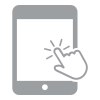SERVICE
 Usability Testing
Usability Testing
During a usability test we watch how users interact with a prototype or website to see if the interface is inhibiting users from accomplishing their desired goals. A user test can be performed on a range of different mediums: paper prototypes, clickable PDFs, and/or HTML/CSS prototypes. There are pros and cons to testing on each.
Keep in mind that after conducting a round of testing you will always find something in the interface that needs to be improved on. For this reason, usability testing should never be viewed as a validation procedure that is only performed at the end of design and development. Usability testing is most beneficial and the ROI is greater when testing is done early and iteratively throughout a project development cycle. This is vital to creating a usable interface.

Our Process
This process may differ slightly based on your projects needs.
Define what we are testing...
As a first step, we prefer to have meetings with the project stakeholders to get an understanding of exactly what you would like to have tested. In these meetings we try to understand why you think testing is the best option for you and what you hope to learn from the results. We also want to gather a lot of information about your business (main competitors, business goals, target audience(s), etc.).
Define who we are testing...
In our initial meeting with you we expect to get as much detailed information as possible on your current or prospective users. We then prefer to conduct user research on your users to gain an understanding of how they currently use your website (or would expect to) and what their needs and goals are.
Define the tasks we are testing...
After conducting the user research and getting an understanding of how people use (or would use) your website or application, we can now go about creating the tasks and scenarios that should be included in the user test. Designing the tasks to make sure the test stays "true", by making sure they are not leading, is crucial to the validity of the test.
Recruit users...
Making sure the right users are recruited is imperative to ensuring that the findings of the testing are actionable. The last thing you want to do is waste all the time and money of testing on people who aren't even representative of your target audience. In order to make sure the right users are recruited we will create a recruiting screener for you. We will also help you hire and manage a recruiting agency (if necessary), and follow-up with their candidates to make sure they are a right fit.
Prepare the test...
If the testing is being conducted on something other than a functional website then we will need to prepare a prototype to test. Preparation for testing also entails securing the testing facility and conducting a practice dry run of the test. If you don't conduct a dry run before you test then your first test becomes your dry run -- something that should always be avoided.
Facilitate testing...
On the day(s) of testing we will facilitate the tests either remotely or in-person at a formal usability lab or a quiet conference room. We will capture and record the audio and screen movements of each user test. Our preference is to get your team involved in the testing. We believe that it's important for members of the design, development, and business team to observe as many of the tests as possible. It's invaluable for them to receive user feedback first-hand.
Discuss and analyze the findings...
One of the most important steps in usability testing, and yet often skipped by a lot of firms, is conducting a thorough debrief with the observers after testing is complete. Usability testing should not be performed while working in a vacuum. The data and feedback collected from end users is not complete without understanding the observers’ perspectives. The process for running an observer debrief involves getting all the observers (and even people who did not observe, but should have) to attend a meeting where we go through their notes for each test and document their observations and perceived implications.
Present the findings...
After all the testing has been conducted we prefer to document all of our findings in a formal report and present the imperative findings to you in-person. The presentation may include highlight videos depending on the audience and your needs. Our recommendation is to have as many team members as possible attend the presentation in order to avoid the issues and lost time in relaying the information.